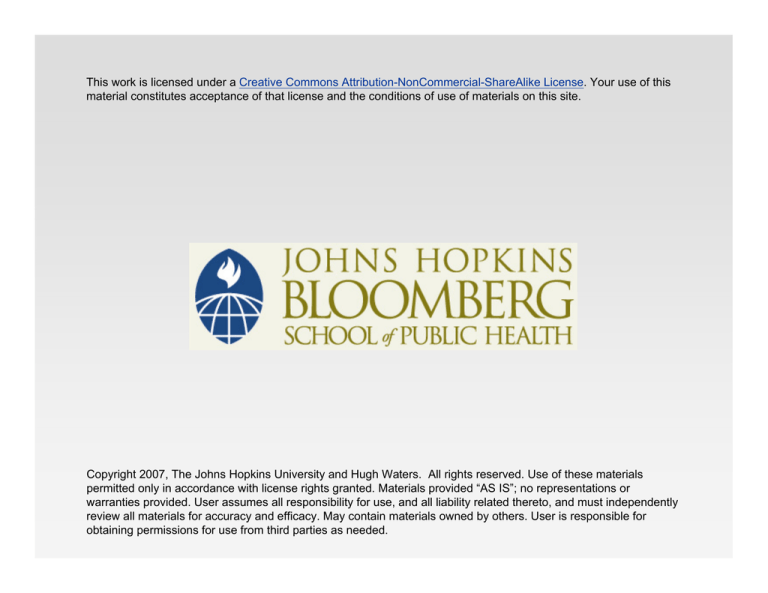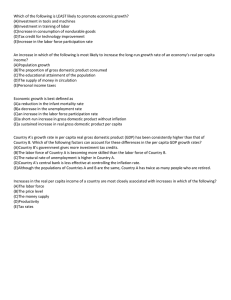
This work is licensed under a Creative Commons Attribution-NonCommercial-ShareAlike License. Your use of this
material constitutes acceptance of that license and the conditions of use of materials on this site.
Copyright 2007, The Johns Hopkins University and Hugh Waters. All rights reserved. Use of these materials
permitted only in accordance with license rights granted. Materials provided “AS IS”; no representations or
warranties provided. User assumes all responsibility for use, and all liability related thereto, and must independently
review all materials for accuracy and efficacy. May contain materials owned by others. User is responsible for
obtaining permissions for use from third parties as needed.
Private Insurance and Managed Care An International View
Hugh Waters
February 22, 2007
Outline of Talk (1) Comparison of Health Expenditures Internationally (2) Overview of Types of Health Insurance Internationally (3) Experience of U.S. Health Insurance Companies in Latin America (4) Example of Chile Health Care Expenditures Internationally Health Spending and Income, by Country, 2004
Health Expenditures per Capita
$6,000
$5,000
$4,000
$3,000
$2,000
$1,000
$0
$0
$10,000
$20,000
$30,000
Per‐capita Gross National Income (PPP)
$40,000
Health Spending and Income, by Country, 2004
Health Expenditures per Capita
$6,000
$5,000
$4,000
$3,000
$2,000
$1,000
$0
$0
$10,000
$20,000
$30,000
Per‐capita Gross National Income (PPP)
$40,000
Under‐Five Mortality and Income, by Country, 2004
350
Under Five Mortality Rate
300
250
200
150
100
50
0
$0
$10,000
$20,000
$30,000
Per‐capita Gross National Income (PPP)
$40,000
Under‐Five Mortality and Income, by Country, 2004
350
Under Five Mortality Rate
300
250
200
150
100
50
0
$0
$10,000
$20,000
$30,000
Per‐capita Gross National Income (PPP)
$40,000
Health Spending as % of GDP, by Country, 2004
Health Expenditures as % of GDP
16%
14%
12%
10%
8%
6%
4%
2%
0%
$0
$10,000
$20,000
$30,000
Per‐capita Gross National Income (PPP)
$40,000
Health Spending as % of GDP, by Country, 2004
Health Expenditures as % of GDP
16%
14%
12%
10%
8%
6%
4%
2%
0%
$0
$10,000
$20,000
$30,000
Per‐capita Gross National Income (PPP)
$40,000
Types of Health Insurance Internationally Types of Pooling Arrangements
Health
Insurance
Systems
National
Health
Insurance
(MOH)
Social
Insurance
Single
Multiple
Community Risk
Sharing
Private Insurance with Competition
Fee for Service
Managed
Care
Source: Akiko Maeda and Cristian Baeza, the World Bank
Social Health Insurance
Health insurance through payroll tax.
Sometimes mandatory for designated population,
but eligibility requires that the enrollee has paid the
premium (contribution).
Social insurance is not a right of every citizen.
Social insurance programs are financially
autonomous and have to maintain solvency.
National Health Insurance
Government collects funds and also (generally) acts
as a health care provider.
Most NHI programs are mandatory, have universal
coverage, financed from general government
revenues.
Roles for Public and Private Health Insurance
Uninsurable risks for private sector:
Non-random health care risks.
Very low-cost services.
Uninsurable individuals or groups.
Roles for private insurance:
Coverage for those ineligible for public
insurance.
Supplemental coverage for services not covered
by a universal public insurance program.
Potential for competition in the context of
universal coverage.
Private – Public Integration
Insurance
Provision
Private, risk related,
Market
Public, salary related,
Command and Control
Individual Private
Insurance
Population-based
Social Insurance
Private Provider
Public Provider
Demand side provider Supply Side provider
financing mechanism Financing Mechanisms
Private – Public Integration
Insurance
Provision
Private, risk related,
Market
Public, salary related,
Command and Control
Individual Private
Insurance
Population-based
Social Insurance
Private Provider
Public Provider
Demand side provider Supply Side provider
financing mechanism Financing Mechanisms
Public Sector Purchasing from the Private Sector
Private health care often considered of higher quality
than public services.
A demonstrated willingness to pay for perceived
higher quality care. Examples – Thailand,
Zimbabwe.
Examples of contracting with private sector
providers – Peru, El Salvador, Guatemala,
Cambodia.
Constraints – limited competition, public financing
and institutional capacity – including human
resources and information systems.
Private Insurance Companies as Purchasers
The average contribution of formal private insurance
to total health spending is just 3.3 %.
But in some countries it is as high as 43% – and in
many low and middle-income countries private
insurance coverage is growing.
In low and middle-income countries, very limited
evidence of impact on quality.
Private Insurance as % of Health Spending, by Country, 2004
Private Ins. as % of Health Spending
60%
Uraguay
50%
40%
30%
20%
10%
0%
$0
$10,000
$20,000
$30,000
Per‐capita Gross National Income (PPP)
$40,000
Private Insurance as % of Health Spending, by Country, 2004
Private Ins. as % of Health Spending
60%
Uraguay
50%
40%
30%
20%
10%
0%
$0
$10,000
$20,000
$30,000
Per‐capita Gross National Income (PPP)
$40,000
Private Insurance as % of Health Spending, by Country, 2004
Private Ins. as % of Health Spending
60%
South Africa
50%
40%
30%
20%
10%
0%
$0
$10,000
$20,000
$30,000
Per‐capita Gross National Income (PPP)
$40,000
Private Insurance as % of Health Spending, by Country, 2004
Private Ins. as % of Health Spending
60%
50%
40%
Bahamas
30%
20%
10%
0%
$0
$10,000
$20,000
$30,000
Per‐capita Gross National Income (PPP)
$40,000
Private Insurance as % of Health Spending, by Country, 2004
Private Ins. as % of Health Spending
60%
50%
40%
United States
30%
20%
10%
0%
$0
$10,000
$20,000
$30,000
Per‐capita Gross National Income (PPP)
$40,000
Experience of U.S. Companies
in Latin America
Characteristics of Managed Care Readiness
Overall System Structure
Country
Centralized Government Control
Consumers
Providers
Autonomy Consumer Consumer Clinical Service Financial UR / EBM of Choice Choice Provider controls and Care Population Health of Health of and Integration
Orientation Management Plan Plan
Provider Incentives Tools
U.S.
‐/‐
+/++
++/++
++/+
+/++
+/++
‐/++
+/++
U.K.
++
+
‐‐
‐
+
+
++
+
Chile
+
+
+
+
‐
+
‐
‐
Canada
++
‐‐
‐‐
+
‐‐
‐
‐
‐
Sweden
++
‐
‐‐
‐
+
+
+
‐
Germany
+
‐
+
++
‐
+
‐
‐
France
+
‐
+
+
‐
‐
‐
‐
Managed Care Companies in Latin America • Multinational insurers are active in Argentina and Chile, and have begun in Brazil. • Three ways that multinational corporations invest finance capital in Latin American: (1) Purchasing companies that sell indemnity insurance or prepaid health plans; (2) Joint‐ventures with other companies; (3) Agreements to manage social security and public sector institutions. Managed Care Companies in Latin America • The main multinational companies operating are Aetna, CIGNA, the EXXEL Group, the American International Group (AIG), International Medical Group (IMG), and Prudential. • In Chile, Aetna controls a subsidiary, Aetna Chile Seguros Generales, and created an ISAPRE –
Aetna Salud – in 1993, which has 60,000 insured subscribers (5th among the ISAPREs). Managed Care Companies in Latin America • In Argentina, Aetna operates through investments in the EXXEL Group and bought the largest and oldest prepaid insurance plan in Argentina, Asistencia Médica Social Argentina (AMSA). • CIGNA operates in Chile, Brazil and Ecuador. Private Insurance Internationally • Only a few countries in the world have a national health system based primarily or heavily on multiple private insurers. • Among high‐income countries, a national system based on multiple private insurers exists only in the United States • Even in the U.S., public sources account for 45% of health expenditures nationwide. Roles for Private Insurance Internationally • Supplementary benefits for higher‐income population groups. • Administrating public insurance. • Managed care in developed health systems. • Increase investment in health; allow government to focus on lower‐income groups. • Other nations with a substantial private insurance market include Chile, South Africa, and the Philippines. Private Insurers and Public Insurance Currently, the most common administrators of health benefits include: • National government • Regional government • Social insurance funds • Private insurers or Managed Care Organizations (MCOs) • Quasi‐autonomous non‐governmental management units (for example locally controlled “Primary Care Trusts” in the UK)
Exporting Managed Care • In countries with a growing middle class, MCOs can play a complementary role to the public system – although others believe that such private plans can potentially undermine the public system. • These complementary plans can be purchased either by employers or the individuals themselves. Example – the Philippines • Spends just 3.2 percent of its GDP on health.
• Has 35 private insurance companies. • The primary driving force behind this process is the need for access to quality heath services in the private sector. • In principle, the government is able to reallocate its limited resources and strengthen its programs for the poor. Managed Care in Developed Health Systems
• In high‐income countries, policymakers have suggested that competing health plans could offer benefits to socialized models of care. • Learn from the methods applied by private health insurance and MCOs. • Can efficiency be improved through competition and introduction of internal markets? Issues • Cream‐skimming – experience in Israel show that instead of focusing on improving clinical quality and efficiency, competing sickness funds emphasize in customer amenities and marketing. • Since government funding is based on average cost, without risk adjustment funds will try to select members with the lowest risk, threatening the integrity of the system. U.S. Companies Abroad – Advantages • Processing • Utilization management • Care management • Quality improvement • Design and implementation of provider payment schemes. U.S. Companies Abroad • In the 1990’s managed care companies – including Aetna, CIGNA, United, and Blue Cross Blue Shield plans – formed joint ventures in Latin America, Asia, and Africa. • Now most U.S. MCOs have abandoned their risk‐bearing insurance operations overseas. • Why? Complexity of adapting to local conditions, provider resistance, and anti‐
American or anti‐managed care sentiment. Case Study – UnitedHealth in South Africa • In the 1990’s, United formed a joint venture with Southern Life, a South African insurance company, and Anglo‐American Corporation, a large mining conglomerate. • Faced several challenges including negative physician response and bad press. • When the Anglo‐American Company made an independent business decision to divest of its non‐mining businesses, the joint venture was effectively abandoned. Case Study – UnitedHealth (cont.) Several factors contributed to the failure: (1) Over‐commitment of resources; (2) Failure to recognize the importance of direct patient‐pay pharmaceuticals as a source of revenue for physicians; (3) Failure to gain the support of employers; and (4) Lack of full understanding of the complex racial situation in South Africa. Current Situation • United and a few other U.S. MCOs – including Kaiser Permanente and CIGNA – maintain international operations. • Consulting and administrative services – and
partnerships for healthcare provision. • Insurance products are limited mainly to U.S. expatriates and those working for U.S. companies abroad. Chile –
Case Study Chile • Population – 16.1 million. • GDP per capita (PPP) – $10,874. • Health expenditures $489 per capita. • Total Fertility Rate (TFR) – 2.0. • Life expectancy at birth – 78.0. • OOP as % of total health spending – 23.7%. Source: 2006 World Development Indicators
Chile – Declining Total Fertility Rate
Chile – Declining Poverty Rate
Chile – Health Sector Organization
Health Sector
Public subsector
Private subsector
18 private health insurance plans
(ISAPRES): 2.8 million beneficiaries
(18.5 % of population)
Curative and
preventive health
insurance
National Health Fund (FONASA): 10.3
million beneficiaries (67.5%)
Public health
interventions
National programs funded and managed by the Ministry of Health (i.e. free
vaccination, TBC treatment, Hanta virus control, PNAC, etc.)
Insurance must finance annual preventive physical examination for each beneficiary.
Providers
28 Regional Health Services (SS) make up
a complex network of 194 public hospitals,
specialty centers, and (mostly municipal)
primary care centers.
31.804 hospital beds
Stewardship and
Regulation
Network of providers, located mainly in
major urban centers.
11.208 hospital beds (including mutual
fund hospitals)
Ministry of Health (both subsectors) through Regional Health Services
Private health insurance regulatory
agency (Superintendencia de Isapres)
Source: Ministry of Health (www.minsal.cl) and FONASA (www.fonasa.cl).
Health Financing
Health expenditures $581 per capita.
Health care system financed through the public
National Health Fund (Fondo Nacional de Salud –
FONASA), and a group of private insurers
(Instituciones de Salud Previsional – ISAPREs).
Employed individuals not otherwise covered are
required to contribute 7% of their income to
FONASA (up to a maximum of approximately
US$135). or to purchase health insurance from an
ISAPRE.
Coverage
From 1981, possible to opt out FONASA and
into ISAPREs.
ISAPREs cover 20% of the population (from
2% in 1983) and FONASA 67%.
There are currently 17 ISAPREs, covering 20%
of the population (from 2% in 1983), vs. 67% for
FONASA.
Coverage (cont.)
The ISAPREs, by law, set premiums at
community rates – by age, sex and family size.
Other private insurance companies offer
differentiated plans that vary according to the
premium paid and the health risk of the insured
family.
FONASA’s rates are tied only to income. People
can buy health insurance simply by paying 7% of
their income, independent of their age, number
of beneficiaries, or health status.
Chile ‐ Source of Health Insurance, 2000
100%
90%
% in FONASA
80%
% in ISAPREs
70%
60%
50%
40%
30%
20%
10%
0%
1 (poorest)
2
3
Income Quintile
4
5 (richest)
Coverage (cont.)
Wealthier Chileans went to ISAPREs – example of
adverse selection.
9.0% of FONASA's risk pool is over 65 years of age,
compared to only 2.2% of the ISAPREs' beneficiaries.
The ISAPREs' beneficiaries have a mean monthly
income of $554 (1998 estimate) while the majority of
FONASA beneficiaries have a mean monthly income
of less than $154.
FONASA’s Benefit Package
Beneficiaries have access to a network of primary care
centers that are mostly managed by municipal
governments.
The primary health care centers must deliver a
predefined package of health services, the Primary
Care Program
ISAPRE’s Risk Rating Table
Insured
Dependants
Age
Months
Years
Male
Female
Spouse
Male
Female
00 - 11
2,40
2,40
2,40
3,00
3,00
12 - 23
2,40
2,40
2,40
2,40
2,40
02 - 17
1,10
2,30
2,50
1,10
1,10
18 - 24
1,00
3,00
2,50
1,00
1,30
25 - 39
1,00
4,20
3,30
1,00
3,30
40 - 49
1,60
3,80
2,70
1,40
2,70
50 - 59
2,10
3,90
2,80
2,00
2,80
60 - 64
4,00
4,50
3,60
3,60
3,60
65 - 69
5,10
5,10
4,30
5,50
4,30
70 - más
5,70
5,50
5,20
6,70
5,20
Source: Ministry of Health (www.minsal.cl) and FONASA (www.fonasa.cl).
Criticisms
This mixed system of insurance has been criticized
principally because of an alleged negative effect on
equity.
One specific criticism is that permitting the rich to
opt out of the public health system diminishes what
some call the system’s ‘‘solidarity.’’
Public opinion surveys show that a majority think that
access to good health services is not available to all
Chileans.
Current Reform Efforts
• The Standard Guaranteed Benefit Package
(SHP)
• Integrating two systems:
– Resolving problems in the current public –
private interaction.
– Identifying sources and mechanisms for
ensuring cross-subsidization.







